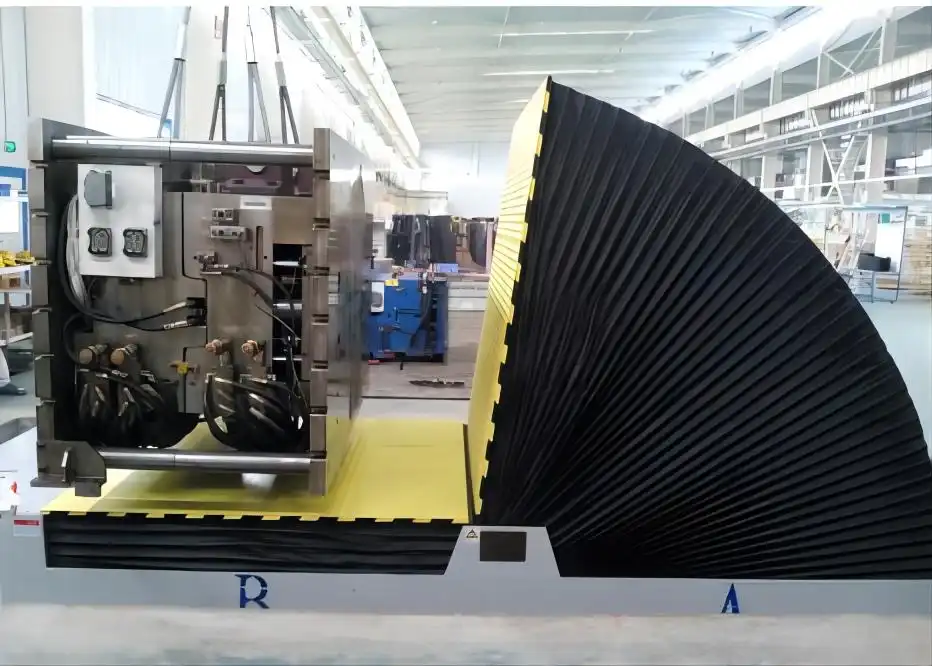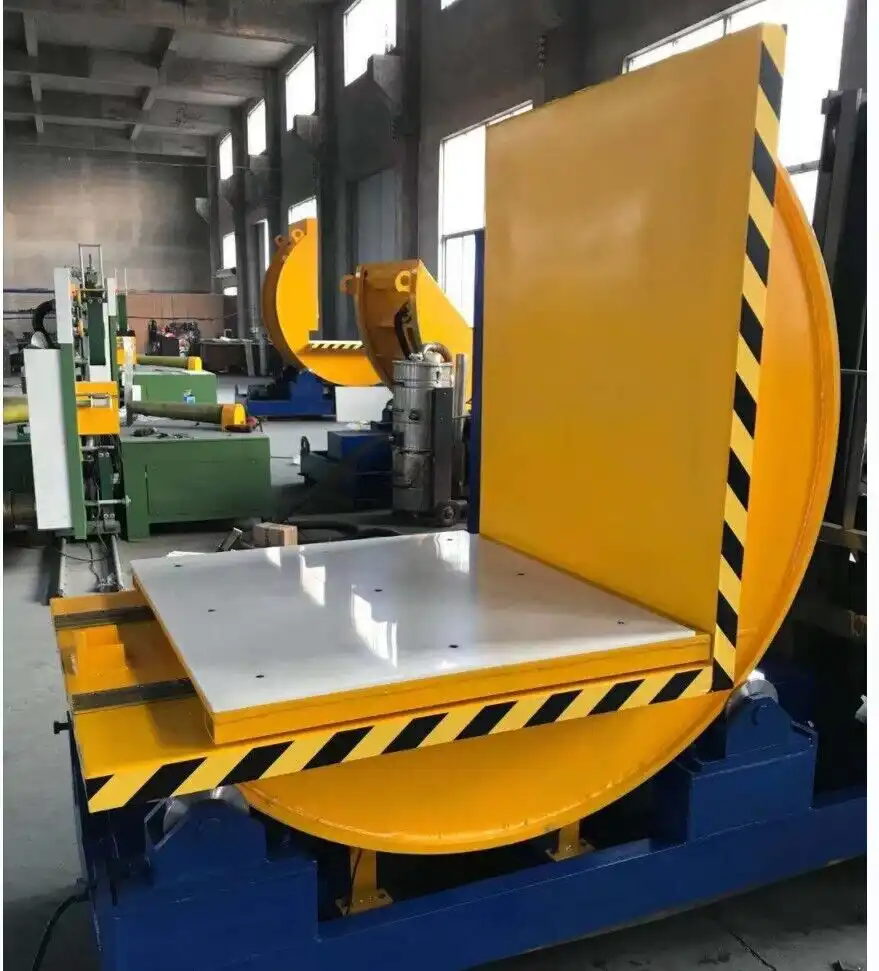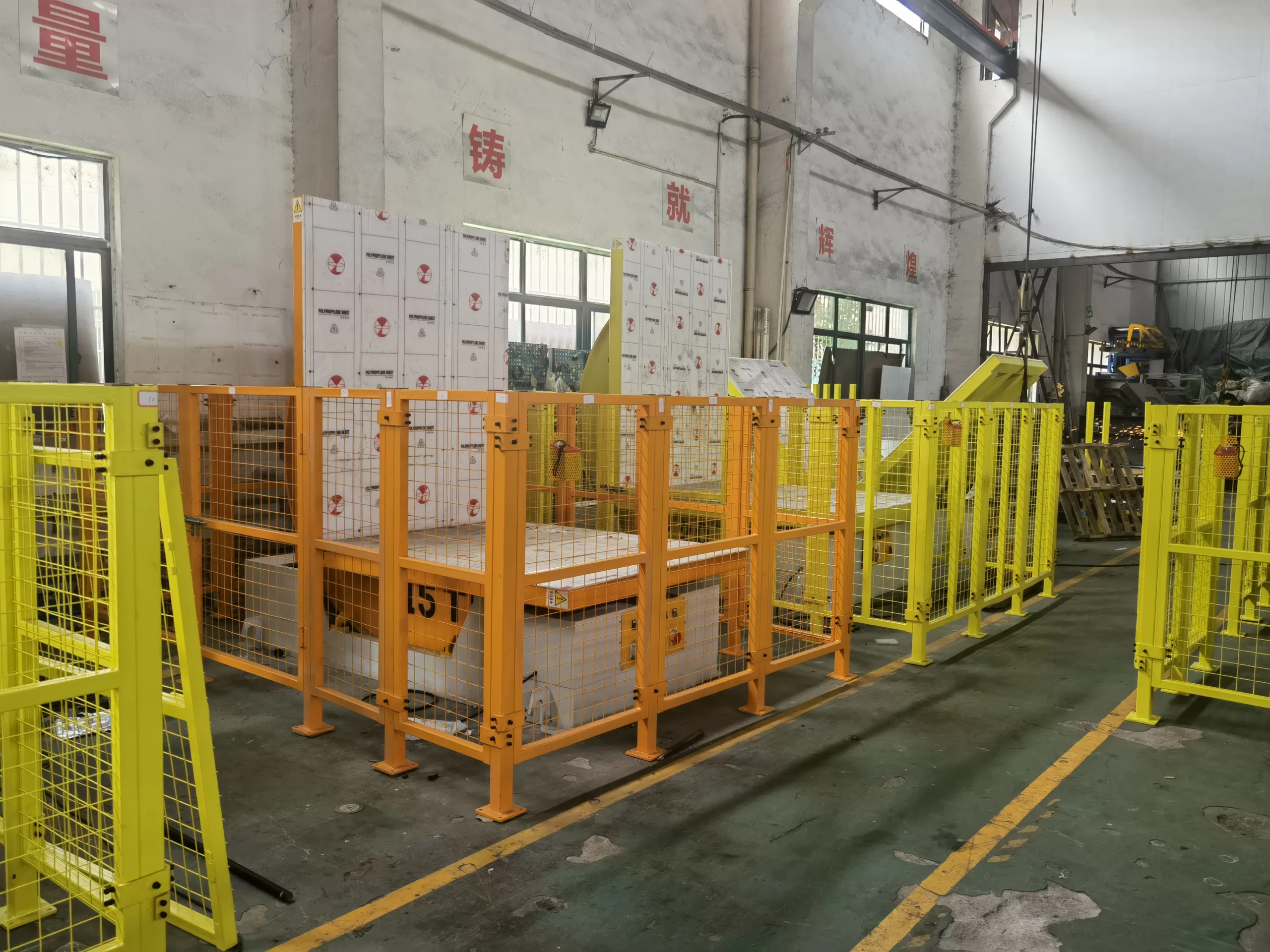Upender Machine Changeover: Can One-Touch Recipes Cut Cycle Time by 40%?
In a busy steel mill, every second counts. You watch your production line, and you see a hidden bottleneck that quietly steals time and money: the changeover process for your upender or tilter. An operator manually adjusts settings for each different coil size. It's slow, it relies on human judgment, and every adjustment is a moment your line isn't running at full capacity. This lost time adds up, day after day, hurting your productivity and your bottom line. What if you could reclaim that time, making your changeovers faster, more consistent, and completely automatic with the press of a single button?
Yes, implementing a modern upender with a "one-touch recipe" system can absolutely cut your changeover cycle time, often by 40% or even more. This technology works by pre-programming and saving the ideal settings—like clamping pressure, tilting speed, and positioning—for each of your specific coil types, eliminating manual adjustments and guesswork.
%[alt: A modern coil upender machine from SHJLPACK in a factory setting](https://www.fhopepack.com/blog/wp-content/uploads/2023/07/our-work-upender-768x763.webp "Modern Coil Upender Machine")
I've been in the packaging machine industry for a long time, first as an engineer and now as a factory owner myself. I’ve seen firsthand how small inefficiencies can create big problems. A slow changeover isn't just a minor delay. For a steel mill owner like you, Javier, it's a direct hit to your goals. It works against your efforts to improve capacity utilization and lower operational costs. But this is a solvable problem. Let's break down how this technology works, what the real financial return looks like, and what to watch out for.
How Do "One-Touch Recipes" Actually Work on an Upender?
You hear a term like "one-touch recipe" and it's easy to be skeptical. It can sound like a marketing gimmick. As an engineer and business owner, you need to know what's happening inside the machine to trust the claims. You're worried that it's just a fancy button that doesn't deliver real-world results, leaving your team to deal with a complicated system that doesn't work. Let's pull back the curtain and look at the simple, effective mechanics behind this system.
One-touch recipes work by using a PLC (Programmable Logic Controller) to store and execute a set of pre-defined parameters for different coil specifications. When an operator selects a recipe on the HMI (Human-Machine Interface), the PLC automatically commands the upender's hydraulic or electric systems to adjust settings like platform positioning, clamping force, and tilt speed to the exact requirements of that coil, ensuring a perfect cycle every time.

Dive Deeper: From Manual Guesswork to Digital Precision
To truly appreciate the change, let's compare the old way with the new way. For years, I saw operators perform these changeovers manually on older equipment. It's a process that relies heavily on experience, but it's also prone to error and inconsistency.
The Traditional Manual Process
With an older, non-recipe-based upender, the operator's job is complex.
- A new coil size arrives at the station.
- The operator must manually measure or eyeball the coil's dimensions.
- They then walk to the control panel and individually adjust hydraulic pressures or mechanical stops.
- They might need to run a slow test cycle to ensure the clamping is secure but not damaging.
- If the coil is off-center, more small adjustments are needed.
This entire process can take several minutes. Over a full day with multiple coil changes, this adds up to significant downtime. It also introduces risks. Too much clamping pressure can damage a steel coil's edges. Too little can create a safety hazard.
The One-Touch Recipe Process
Now, let's look at the same task with a modern system. This is a core part of the digital transformation you are aiming for.
- A new coil size arrives.
- The operator looks at the work order, which specifies "Coil Type B-12."
- On the HMI screen, they simply select the pre-saved recipe named "B-12."
- The operator presses "Start."
The machine does the rest. The PLC instantly sends signals to various components. Sensors provide real-time feedback to ensure every action is precise.
Here’s a breakdown of what happens behind the scenes:
| Component | Function in the Recipe System | Benefit for Your Mill |
|---|---|---|
| PLC (The Brain) | Stores dozens of recipes. Each recipe is a list of commands and values. | Guarantees 100% consistency. Every changeover for "Coil Type B-12" is identical. |
| HMI (The Interface) | A simple touchscreen where the operator selects the named recipe. | Drastically reduces training time and eliminates human error in setting parameters. |
| Position Sensors | Precisely measure the location of the V-saddle and clamping arms. | Ensures the coil is perfectly centered and held, reducing risk of damage or slippage. |
| Pressure Transducers | Monitor and control the hydraulic pressure for clamping. | Applies the exact force needed—no more, no less. Protects coil integrity. |
| Variable Speed Drives | Control the speed of the tilt, allowing for smooth acceleration and deceleration. | Minimizes mechanical stress on the upender and protects the coil from sudden jolts. |
This isn't just about speed. It is about data and control. Each cycle's data can be logged and sent to your MES, contributing to your goal of total production visibility. It turns a variable, manual task into a predictable, digital, and efficient part of your process.
What's the Real ROI on Upgrading to a Recipe-Based Upender System?
As the owner of a steel mill, you live and die by the numbers. A new machine isn't a toy; it's a capital asset that must justify its existence. The upfront cost of a modern upender with advanced controls can seem high compared to a basic model. You have to answer to your budget, and you need to be certain that the investment will pay for itself. It's not enough to hear that it's "more efficient." You need a clear path to return on investment (ROI) that you can take to the bank.
The real ROI on upgrading to a recipe-based upender is a powerful combination of direct cost savings and massive productivity gains. The payback period is often between 18 and 36 months, driven by reduced labor per changeover, increased machine uptime, lower energy consumption, and a significant decrease in product damage.

Dive Deeper: A Practical Calculation for Your Mill
Let’s be pragmatic and run some numbers. I've helped many clients walk through this exact calculation. While your specific numbers will vary, this framework will show you where the value comes from. It’s the same kind of feasibility analysis you conduct for any major investment.
Let's make some reasonable assumptions for a mill like yours:
| Metric | Assumption |
|---|---|
| Operating Days / Year | 300 |
| Shifts / Day | 3 |
| Changeovers / Shift | 5 |
| Manual Changeover Time | 5 minutes |
| Recipe-Based Changeover Time | 1 minute |
| Time Saved / Changeover | 4 minutes |
| Labor Cost (fully burdened) | $30 / hour |
| Value of Production Uptime | $500 / hour |
| Energy Savings / Hour of Idle Time | $5 / hour |
Now, let's calculate the annual savings.
1. Labor and Uptime Savings
- Total Changeovers / Year: 5 changeovers/shift 3 shifts/day 300 days/year = 4,500 changeovers/year
- Total Time Saved / Year: 4,500 changeovers * 4 minutes/changeover = 18,000 minutes = 300 hours/year
This 300 hours is the core of your ROI. It generates value in two ways:
- Direct Labor Savings (if you can reassign the operator): 300 hours * $30/hour = $9,000 / year
- Increased Production Value (the true prize): This is time your line is now running instead of waiting. 300 hours * $500/hour = $150,000 / year
2. Energy Savings
The machine isn't working as hard during a fast, automated changeover. And it's not sitting idle for as long with the hydraulics running. It's a modest but real saving that addresses your challenge with volatile energy costs.
- Energy Savings: 300 hours saved * $5/hour energy cost = $1,500 / year
3. Reduced Product Damage
This is harder to quantify, but it's very real. Manual clamping can easily damage the edges of a valuable steel coil. Let's be conservative.
- Assumption: One damaged coil per month due to handling errors, at a loss of $2,000 per coil.
- Damage Prevention Savings: 12 months * $2,000/month = $24,000 / year
Total Estimated Annual Savings:
$150,000 (Uptime) + $9,000 (Labor) + $1,500 (Energy) + $24,000 (Damage) = $184,500 / year
If the incremental cost for the recipe-based system is, for example, $300,000, your payback period is under 20 months. This is the kind of hard data that justifies an investment. It directly targets your goals of increasing capacity utilization to 95% and lowering overall operating costs. It’s a clear win.
Are There Hidden Risks or Costs in Implementing This Technology?
I believe in being honest about technology. As an engineer, I know that no solution is perfect, and as a business owner, I know that unexpected problems are the most expensive kind. You've gotten to where you are by being forward-thinking but also cautious. You understand that new equipment can bring new headaches. Ignoring the potential downsides of a recipe-based upender would be a mistake. It could lead to a frustrated team, project delays, and a machine that never delivers on its promise.
Yes, there are hidden risks and costs. The primary ones are a lack of proper operator and maintenance training, difficult integration with your existing factory control systems, and the risk of choosing a supplier who provides poor after-sales support for the software and electronics, leaving you stranded.

Dive Deeper: Facing the Challenges Head-On
A strategic partner doesn't just sell you a machine; they help you anticipate and solve these problems. Having overseen countless installations, I've learned to spot these risks early. Let's look at them one by one.
The Training Gap: From Levers to Touchscreens
Your current team might be experts with wrenches and hydraulic levers. Moving to an HMI touchscreen requires a different skill set.
- The Risk: Operators may be intimidated by the new interface. They might resist the change or use the system incorrectly, overriding the benefits. Your maintenance team may not be prepared to troubleshoot PLC logic or sensor faults.
- The Solution: A good supplier must provide more than a manual. They should offer comprehensive, on-site training for both operators and maintenance staff. The training should be hands-on, using your specific recipes. At SHJLPACK, we see training as a critical part of the handover. We don't leave until your team is confident and capable.
The Integration Hurdle: Making New and Old Systems Talk
Your goal is full production visualization through an MES. This new upender needs to be a part of that digital ecosystem, not an isolated island.
- The Risk: The machine's PLC might not communicate easily with your plant's host system. Different communication protocols (like Profinet, EtherNet/IP) can create a software nightmare if not planned for. You could end up with a machine that works but doesn't share its data, defeating a key part of your digitalization goal.
- The Solution: This must be discussed upfront. Before you even sign a purchase order, you need to define the integration requirements. Your supplier's engineering team should be able to speak directly with your IT or automation team to guarantee seamless data exchange. A true partner will have experience with this and can show you examples of successful integrations.
The Supplier Partnership Risk: What Happens After a Year?
This is perhaps the biggest risk of all. You buy a machine that works great for the first year. Then, a sensor fails, or you need to add a new recipe for a new product, and you discover your supplier is unresponsive or has gone out of business.
- The Risk: The machine becomes a "black box." You can't modify the software, and sourcing proprietary electronic components is impossible. A simple PLC fault could take the machine down for weeks.
- The Solution: You must vet your supplier for their long-term viability and support structure. Ask them tough questions: What is your standard warranty? Do you offer remote diagnostic support? How do you handle software updates? What is your spare parts guarantee for electronic components? A cheap price tag from an unreliable supplier is the most expensive mistake you can make.
My Insights: Why a True Partner Looks Beyond the Machine's Price Tag
It is easy to get bids from three different suppliers and put them in a spreadsheet. The machine with the lowest price often stands out. I understand the pressure to manage capital expenses. But my journey in this industry, from working on the factory floor to building my own successful company, has taught me one crucial lesson: the price on the quote is only the beginning of the story. A machine is not a one-time purchase; it is a 15 or 20-year relationship.
A true partner looks beyond the initial sale to understand your strategic goals. They don't just sell you an upender; they provide a comprehensive solution that includes consulting, seamless integration, robust training, and long-term support. They become an extension of your own engineering team, helping you tackle your biggest challenges.

Dive Deeper: My Perspective as an Engineer and Factory Owner
Javier, your story resonates with me. You started on the ground floor and built a major enterprise. You know the difference between an expense and an investment. When I started SHJLPACK, I didn't just want to build machines. I wanted to build the kind of company I would have wanted to buy from when I was an engineer facing production targets. I wanted to build a company that solves problems, not just ships boxes.
This is what a real partnership looks like in practice, and it's what you should demand from any supplier:
1. Consultative Design and Selection
A partner doesn't start with a catalog. They start with questions. They want to understand your challenges with energy costs, environmental pressures, and market fluctuations. They'll analyze your product mix, your line speed, and your physical space. They might suggest a hydraulic upender for its raw power and cost-effectiveness, or a mechanical one if you have specific environmental or maintenance preferences. The goal is to co-design a solution that fits your unique operation, not just sell a standard model. This process ensures the machine you buy is the machine you actually need.
2. Full-Process Support
The relationship deepens at installation. A partner provides expert technicians who don't just set up the machine but also integrate it with your upstream and downstream equipment. They work with your team to load and test the initial recipes. They conduct the hands-on training I mentioned earlier, ensuring your team is fully prepared. This level of support minimizes disruption and gets you to full production speed faster.
3. Proactive Advice on Future Challenges
Your goals go beyond one machine. You're focused on digitalization and environmental compliance. A strategic partner brings valuable expertise here.
- For Digitalization: They can advise on how to best use the data from the upender's PLC. This data can feed into a predictive maintenance program, alerting you before a component fails. This is a direct path to achieving your 95% uptime goal.
- For Environmental Compliance: They can recommend energy-efficient motors, biodegradable hydraulic fluids, or systems that minimize noise pollution. They are aware of global trends and standards and can help you future-proof your investment.
This is the core mission of SHJLPACK. I achieved my own success because of the opportunities this industry gave me. Now, my goal is to share that knowledge and help others like you succeed. A machine is a tool, but a partnership is a strategic advantage.
Conclusion
A modern upender with one-touch recipes is more than a machine; it's a strategic tool for boosting efficiency, advancing your digital transformation, and securing long-term profitability in a competitive market.





